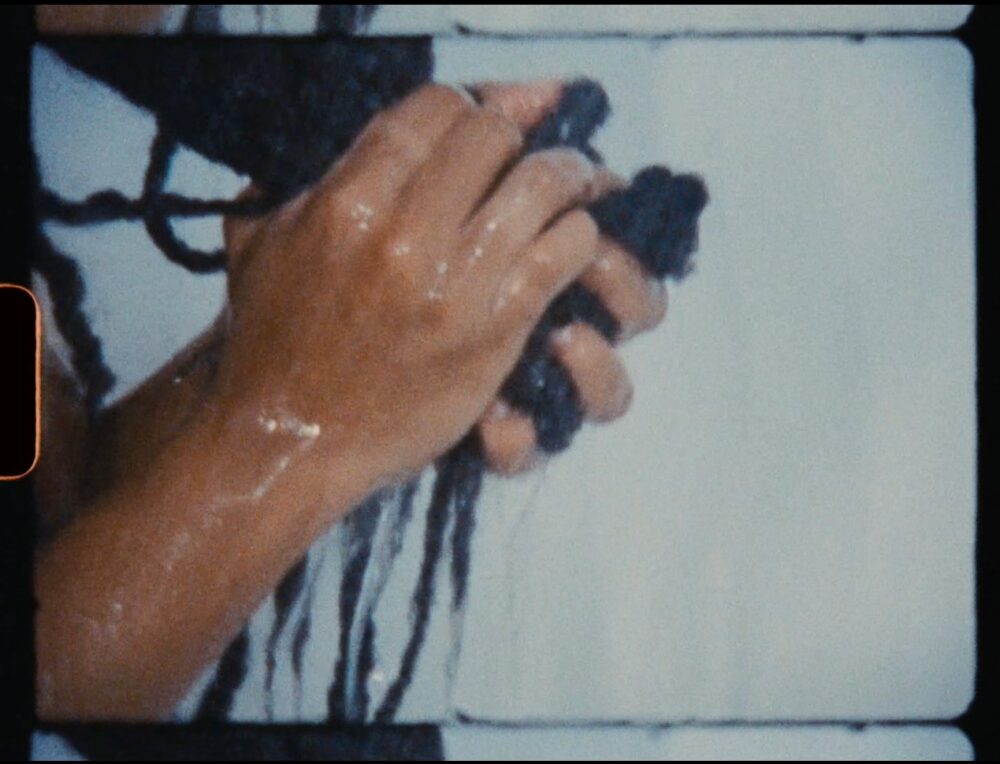January 12, 2022 – February 9, 2022 STREAMING ON THIS PAGE
TO REMEMBER AND REPAIR
curated by Temple Marucci-Campbell
Through Temple Marucci-Campbell’s program, she explores the nuances of a legacy in the wake of trauma, and how a ruptured legacy ignites alternative methods of remembering. Remembering through the interconnectivity of language and bodies while also acknowledging the disparity, breathes new life into existing legacies. Marucci-Campbell considers the question of legacies as it pertains to Black diasporic people. How can ruptured legacies survive within ourselves? How can they be nurtured? TM-C
Be sure to stay tuned as the other titles in Temple’s program become available on the Vtape website each Wednesday until February 9, 2022, when Temple will be in a LIVE ON-LINE conversation with the artists in her program. And on February 16, 2022, the second program of this partnership, Fabiyino Germain-Bajowa’s TELL THE BODY, begins with a live introduction.
WEDNESDAY, FEBRUARY 9, 2022 @7pm ET
Kourtney Jackson, Wash Day, 2020, 9:52.
Kourtney Jackson is a filmmaker and writer from Toronto whose work deals with the nuances of her identity. Wash Day (2020) looks at how private acts of self care can become a way to develop a strong sense of self and the ways Black women can nurture themselves in spite of systems of oppression. Jackson positions hair as a way to find autonomy and ultimately empower Black women, and looks at hair as an extension of an individual that can simultaneously act as armour. Each of the three black women in the film wash their hair differently and provide varying insights on how Blackness influences the cultivation of their identities. Jackson questions aesthetics and societal beauty standards as a way to bring forth narratives that center and empower Black women.
4. Nadine Valcin, Heartbreak, 2016, 1:00.
Nadine Valcin is a Canadian director and producer whose work is concerned with the way race shapes individual identity. Valcin confronts the nuances of anti-Black racism through drama and documentary films. Heartbreak (2016) is an intimate ode to a Black mother and her son and uses a child’s perspective to navigate trauma. Heartbreak discusses intergenerational trauma transmitted through maternal relationships and uses heartbreak as a metaphor for the physical and emotional impacts of oppression. Through the whispers of a child, Valcin is speaking on the oppression that Black women and their children are victims of. Black people who carry children carry on legacies, and Valcin acknowledges the contention between generations foregrounded by anti-Black oppression.
3. nichola feldman-kiss, childish objects\ my grandmother took command from her bed. she had a habit of clutching her seized hand become claw to her chest. her fridge was always stocked with lovingly prepared Jamaican dishes in the happenstance of visitors, 2009, 11:11.
nichola feldman-kiss is a Tkaronto-based multidisciplinary artist who asks what it means to be an individual who can embody a multitude of histories and knowledge. She uses her video practice to explore the relationship between bodies and identity. In this work from 2009, feldman-kiss uses her body as an alternative way of remembering, questioning what a personal archive can look like when influenced by diaspora. Through the act of sewing white thread to her fingers she is activating her hand as an object of memory, and tapping into an archive through sensorial confrontation.
2. Kyisha Williams, Red Lips (Cages for Black Girls), 2010, 17:47
Kyisha Williams is a multidisplinary artist from Tkaronto, whose art practice is concerned with social issues from a Black-Queer Persepctive. In their film Red Lips [Cages for Black Girls] (2010), Williams explores what it means to survive as a Black Queer Person in Toronto. Williams celebrates the nuance of gender and sexual expression as an outlet for Black people in the wake of oppresive systems. Williams specifically illustrates how the prison industrial complex bleeds into the relationships Black Queer people have with eachother. In the face of oppression the individuals in this film find power in themselves and one another granting each other agency and subverting anti-Black systems of power.
1. Christene Browne, From Nevis To, 1987, 7:00
Christene Browne is a Canadian Writer and Director based in Toronto, Canada. She was the first Black woman in Canada to direct a dramatic feature and has amassed international recognition for her work. Browne’s From Nevis To (1987) is a docu-drama that confronts ways to remember in the wake of new surroundings. The film follows Juliet Jones as she migrates to Canada from Nevis, an island in the West Indies. In the isolation of her hotel room she confronts the passing of time and the way her physical surroundings have changed. Browne examines the intersection between identity and geography, and has Juliet question the way she fits into Canadian society.
Temple Marucci-Campbell is a student at OCADU studying Criticism and Curatorial practices. Her research practice focuses on the intersection of Art and food, where food is a transmitter of sensory knowledge. Marucci-Campbell uses her research practice to connect with her ancestral history and explore alternative ways of remembering.
Image credit: Heartbreak, Nadine Valcin, 2016


